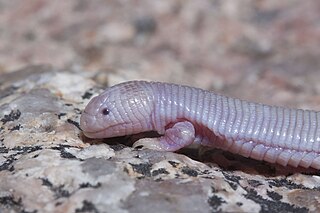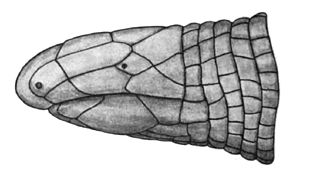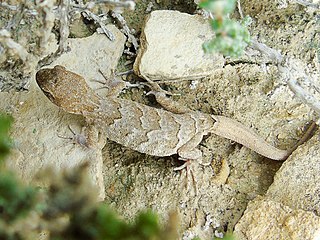
Amphisbaenia is a group of usually legless squamates, comprising over 200 extant species. Amphisbaenians are characterized by their long bodies, the reduction or loss of the limbs, and rudimentary eyes. As many species have a pink body and scales arranged in rings, they have a superficial resemblance to earthworms. While the genus Bipes retains forelimbs, all other genera are limbless. Although superficially similar to the snakes and blind lizards, recent phylogenetic studies suggest that they are most closely related to wall lizards of the family Lacertidae. Amphisbaenians are widely distributed, occurring in North America, Europe, Africa, South America, Western Asia and the Caribbean. Most species are less than 6 inches (15 cm) long.

The Mexican mole lizard, also commonly known as the five-toed worm lizard, or simply as Bipes, is a species of amphisbaenian in the family Bipedidae. The species is endemic to the Baja California Peninsula. It is one of four species of amphisbaenians that have legs.

The Iberian worm lizard, Mediterranean worm lizard, or European worm lizard is a species of reptile in the family Blanidae of the clade Amphisbaenia. The Iberian worm lizard is locally known as cobra-cega (Portuguese), culebrilla ciega (Spanish), and colobreta cega (Catalan), all meaning "blind snake". Recent studies into the mitochondrial and nuclear genomic data of 47 isolated B. cinereus populations show rather large sequence divergence between two apparent clades, leading some researchers to call for a division of the Iberian worm lizard into two species. While little is known of B. cinereus in comparison with some other reptile species, new insight is growing about this primitive, ancestral reptile.

Zarudny's worm lizard is a species of amphisbaenian reptile in the family Trogonophidae. The species is monotypic within the genus Diplometopon. The species is native to the Middle East.

Amphisbaena alba, also known as the red worm lizard or less commonly as the white or white-bellied worm lizard, is a species of amphisbaenian in the reptilian order Squamata. Despite the large geographic range that this species covers, little is known about its ecology due to its secretive habits. A. alba has a diverse diet ranging from plant material to small vertebrates. Numerically, beetles, ants, and spiders compose the majority of their diet; however, ants, insect larvae, beetles, crickets, grasshoppers, and termites are ingested to satisfy a larger volume. The females are somewhat larger than the males, and can reach over 80 cm, which is quite large for an amphisbaenian. They are known to bury themselves in leafcutter ant nests and hide in the ants garbage dump areas to avoid irritating the ants into attacking, and to bury themselves to avoid predation in general.

Amphisbaena mertensii, also known as the Mertens' worm lizard or Mertens's worm lizard, is a species of worm lizard in the family Amphisbaenidae. The species is endemic to South America.

The Lacertoidea is a group of squamate reptiles that includes the Lacertidae, Teiidae, Gymnophthalmidae, and Amphisbaenia. The finding from molecular phylogenetic studies that the burrowing Amphisbaenia were nested in a clade with the lizard forms led Vidal & Hedges (2005) to propose a new name for the group based on shared morphogical characters, Laterata, "referring to the presence of tile-like scales that form the rings in Amphisbaenia, and are also present ventrally in Lacertiformata and Teiformata".

Cadea is a genus of amphisbaenians, commonly known as Cuban keel-headed worm lizards. Two species are placed in this genus. Both species are endemic to Cuba.

Cadea palirostrata, also known as Dickerson's worm lizard or the Cuban sharp-nosed amphisbaena, is a species of amphisbaenian in the family Cadeidae, described by herpetologist Mary Cynthia Dickerson in 1913. This species is endemic to Isla de la Juventud, an island of western Cuba.

Altiphylax tokobajevi, also known commonly as the Kirghizia even-fingered gecko, the Tien Shan even-fingered gecko, and the Tjan-Shan pygmy gecko, is a species of lizard in the family Gekkonidae. The species is native to Asia.
The West African worm lizard is a species of amphisbaenian in the family Amphisbaenidae. The species is endemic to Nigeria.
The Cuban many-ringed amphisbaena, also known commonly as the Cuban many-ringed worm lizard, is a species of amphisbaenian in the family Amphisbaenidae. The species is endemic to Cuba.
The Cuban pink amphisbaena is a species of worm lizard in the family Amphisbaenidae. The species is endemic to Cuba.
Amphisbaena cegei is a species of amphisbaenian in the family Amphisbaenidae. The species is endemic to Bolivia.
Spurrell's worm lizard is a species of amphisbaenian in the family Amphisbaenidae. The species is endemic to Central America and northern South America.
The Mpwapwa worm lizard is an amphisbaenian species in the family Amphisbaenidae. The species is endemic to Tanzania.
Monopeltis capensis, also known commonly as the Cape spade-snouted worm lizard, the Cape wedge-snouted worm lizard, the Cape worm lizard, and the South African shield-snouted amphisbaenian, is a species of amphisbaenian in the family Amphisbaenidae. The species is native to southern Africa.
Monopeltis luandae is a species of amphisbaenian in the family Amphisbaenidae. The species is endemic to Angola.
Monopeltis perplexus is a species of amphisbaenian in the family Amphisbaenidae. The species is endemic to Angola.

The Turkish worm lizard is a species of amphisbaenian in the family Blanidae. The species is native to Southeast Europe and the Middle East. There are two recognized subspecies.









